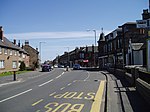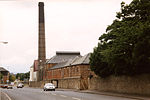Larbert High School
Larbert High School is a six-year, non-denominational state school in Stenhousemuir, Scotland, United Kingdom (UK). The school is run by Falkirk Council Education Services on behalf of the Scottish Government. In 2005, the total running costs of the school were £5,852,498 or £3,553 per pupil. The current rector is Jon Reid. The school was inspected by HM Inspectorate of Education in the 2016/17 session and found to be "Excellent" in the category of "Leadership of Change" and "Very Good" across all other categories. Larbert High was the first school to achieve an "Excellent" rating.As of August 2021 the school roll was 2050 pupils with expectations of growth in future years to come and reach capacity. It is currently considered the second largest secondary school in Scotland. The school is secondary to 7 local primary schools, including Stenhousemuir Primary, Larbert Village Primary, Ladeside Primary, Carron Primary, Kinnaird Primary, Carronshore Primary, and Airth Primary.
Excerpt from the Wikipedia article Larbert High School (License: CC BY-SA 3.0, Authors).Larbert High School
Carrongrange Avenue,
Geographical coordinates (GPS) Address Phone number Website External links Nearby Places Show on map
Geographical coordinates (GPS)
| Latitude | Longitude |
|---|---|
| N 56.02261 ° | E -3.80872 ° |
Address
Larbert High School
Carrongrange Avenue
FK5 3BL , Antonshill
Scotland, United Kingdom
Open on Google Maps









